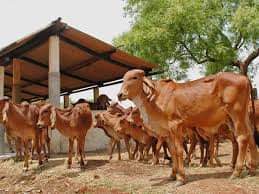How to increase the income of livestock farmers in India
Dr. Jitendra singh
B.V.Sc. & A.H., M.V.Sc. (Animal Genetics & Breeding)
Veterinary officer, Department of Animal Husbandry, Lucknow, U.P.
*Corresponding author: - drjitendra2753@gmail.com
Mob No: 9450260686
Abstract:
Livestock sector plays a multi-faceted role in socio-economic development of rural households. Livestock rearing has significant positive impact on equity in terms of income and employment and poverty reduction in rural areas as distribution of livestock is more egalitarian as compared to land. In India, over 70 percent of the rural households own livestock and a majority of livestock owning households are small, marginal and landless households. Small animals like sheep, goats, pigs and poultry are largely kept by the land scarce poor households for commercial purposes due to their low initial investment and operational costs. In the recent decade, demand for various livestock based products has increased significantly due to increase in per capita income, urbanization, taste and preference and increased awareness about food nutrition. Livestock sector is likely to emerge as an engine for agricultural growth in the coming decades. It is also considered as a potential sector for export earnings.
Introduction:
It is time to restructure and revitalize the present institutional set-up in the livestock sector, enhance institution-level efficiency, and promote new institutional models to handle the emerging challenges in livestock sector development. The efforts should aim to promote and nurture the grass-root level participatory bodies all over the state as the organic link between the animal husbandry department and the smallholders. The share of livestock in agricultural sector GDP growth has been increasing faster than the crop sector in the past decade because of the rising demand for livestock products propelled by income and population growth and urbanization. The livestock sector plays an important role in the socio-economic development of rural households. It contributes about 6 percent to the Gross Domestic Product and 25 percent to the Agricultural Gross Domestic Product.
Challenges faced by the Livestock sector in India:
Improving the productivity of farm animals is one of the major challenges. The average annual milk yield of Indian cattle is 1172 kg which is only about 50 per cent of the global average. The frequent outbreaks of diseases like Foot and Mouth Diseases, Black Quarter infection; Influenza, etc. continue to affect Livestock health and lowers productivity. India’s huge population of ruminants contributes to greenhouse gases emission. Reducing greenhouse gases through mitigation and adaptation strategies will be a major challenge. Crossbreeding of indigenous species with exotic stocks to enhance the genetic potential of different species has been successful only to a limited extent. Limited Artificial Insemination services owing to a deficiency in quality germplasm, infrastructure and technical manpower coupled with poor conception rate following artificial insemination have been the major impediments. After more than three decades of crossbreeding, the crossbred population is only 16.6 per cent in cattle, 21.5 per cent in pigs and 5.2 per cent in sheep. The sector will also come under significant adjustment pressure to the emerging market forces. Though globalization will create avenues for increased participation in international trade, stringent food safety, and quality norms would be required.
Access to markets is critical to speed up the commercialization of livestock production. Lack of access to markets may act as a disincentive to farmers to adopt improved technologies and quality inputs. Except for poultry products and to some extent for milk, markets for livestock and livestock products are underdeveloped, irregular, uncertain, and lack transparency. Further, these are often dominated by informal market intermediaries who exploit the producers.
Likewise, slaughtering facilities are inadequate. About half of the total meat production comes from un-registered, make-shift slaughterhouses. Marketing and transaction costs of livestock products are high taking 15-20 per cent of the sale price.
Other major challenges faced by the sector are inadequate availability of credit, poor access to organized markets, limited availability of quality breeding bulls, water sources depletion, deficiency of vaccines and vaccination set-up, diversion of feed and fodder ingredients for industrial use.
Eradication of Infectious diseases
Infectious diseases are a major burden on the farmers’ economy. The recently launched the National Animal Disease Control Programme (NADCP), aims at eradicating Foot and Mouth Disease (FMD) and brucellosis in livestock. The program aims to vaccinate over 500 million livestock heads, including cattle, buffalo, sheep, goats, and pigs, against FMD, and some 36 million female bovine calves annually against brucellosis. The program has received 100 per cent funding from the Centre, amounting to Rs 12,652 crore for five years until 2024, the release said.
Conclusion:
Policymakers in India are finally acknowledging a structural shift in the agriculture sector they have been noticing for a decade. Livestock now controls a quarter of the agriculture gross domestic product (GDP). The livestock sector is performing well in the manner of production, value addition, and export of dairy, fishery, wool, poultry, and other products. Apart from its performance, some threats also exist; we need to overcome them to grab the global market opportunities
References:
BAHS (2014). Basic Animal Husbandry Statistics. Ministry of Agriculture. Department of Animal Husbandry, Dairying and Fisheries. New Delhi.
CACP (various years), Report of the Commission for Agricultural Costs and Prices, Ministry of Agriculture, Government of India, New Delhi.
DAHDF (2015-16). Department of Animal Husbandry, Dairying and Fisheries. Ministry of Agriculture, Govt. of India, New Delhi.
Report on Doubling Farmer’s Income by 2022-Farm Crisis and Farmers’ Distress 2016. ICAR New Delhi.



